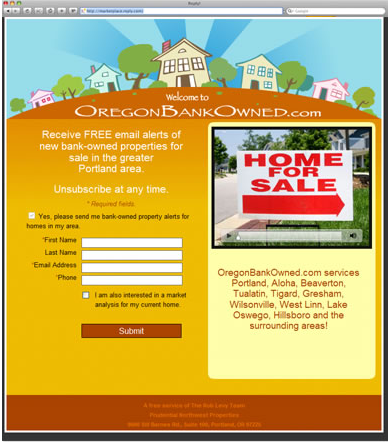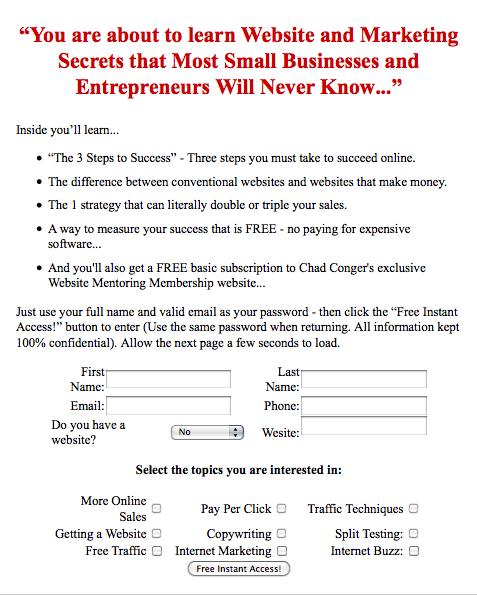Have you ever landed on a website that is obviously trying to collect your contact information or sell you something, but there is no reassurance of a reputable brand or company name? If so, then you have most likely been exposed to the proverbial “black sheep” of the real estate marketing industry – the stealth website.
In this article, we are going to tell you about real estate stealth websites. When used correctly, stealth websites can be extremely effective. There are many pitfalls to using stealth websites though and we want to make sure that you don’t get caught up in any of them.
What is a Real Estate Stealth Website?
Online marketing is all about lead generation. Whether you are spending thousands of dollars on Pay Per Click or hours a day on Search Engine Optimization, in the end the goal is to get your website to generate leads for your business that can be converted into clients and sales.
Stealth sites for real estate are merely vehicles to help real estate professionals generate more leads. To help you recognize a real estate stealth site, here are some common characteristics that classify these sites as being ‘stealth’…
- No apparent company or agent branding
- Generic contact information
- Prominent lead generation forms
- Absence of navigable options
 example provided by RealPro Systems
example provided by RealPro Systems
As you can see in the example above, the main option is to provide your information and the page contains no company or agent affiliation. This is a perfect example of a real estate stealth site.
In actuality, a stealth site is basically a non-branded landing page that many companies and agents use to capture leads. More often than not, stealth sites are tied to paid search marketing campaigns as targeted traffic can be delivered to these sites where the only options for its visitors are to provide their information or leave the site.
Are Stealth Sites Good or Bad?
Many people love to gravitate towards the dichotomies of the world. Things are either black or white, hot or cold, or in this case, good or bad. Well, we hate to disappoint this group of people, but in our opinion, real estate stealth sites are not just ‘good’ or just ‘bad’. They can most definitely be one or the other, but they cannot be pigeon-holed as only one or the other. Our case for both sides are stated below.
Bad Real Estate Stealth Sites
Just about any marketing tactic can be taken over the top and abused. Stealth sites are no different, which is most likely the reason why they have picked up such a bad rap over the past few years. Here are some things that can most definitely make make a stealth site ‘bad’…
- Used to trick people into providing their information
- Captures contact information for the main purpose of abusing that info
- Redirects visitors to a completely irrelevant place
- Features false promises or guarantees to capture lead info
IMPORTANT: According to the NAR Code of Ethics, if your state requires disclosure of your name, phone number, office address, broker, office phone number and you do not provide it as required, then you are in violation of State license law. If you have a free standing url and you own the website and domain, then this applies to you.
Good Real Estate Stealth Sites
Anything can be abused, whether it is a stealth site or a regular website. Assuming that someone is not attempting to be malicious or deceitful with their stealth site(s), these tools can actually be quite effective for capturing leads and converting visitors. Here are some things that can make a stealth site ‘good’…
- Used to reassure visitors that they landed on the correct website for what they were searching for
- Captures contact information for the main purpose of providing something of value in return
- Provides visitors with a trustworthy, user-friendly experience
- Features trust statements, accredited logos and designations, as well as, supportive statements or testimonials from current clients
Have a better ‘good’ example for us to feature? Send it over and we will feature your stealth site.
As you can see from the example above, the company / agent branding is noticeable, something of value is being offered to those who sign up and company / accredited logos are clearly displayed to provide the visitor with comfort and peace of mind.
Tips to Use Stealth Sites Effectively
We have detailed the ‘good’ and ‘bad’ characteristics of stealth sites for real estate. Now, and what you probably have been waiting for, is how to actually use these tools to effectively generate leads without exploiting or deceiving your visitors. Many of this can actually be pulled from the info previously mentioned, but here is a list of some tried and tested tips to maximize your stealth site’s effectiveness.
TIP 1: Be Transparent
If the purpose of your stealth site is to capture leads, then make sure visitors know this. You may be able to get tons of leads by ‘tricking’ people into giving you their information, but the second you follow up or call them, they are so perturbed by their experience or completely caught off guard that the time you spent following up was wasted.
DO THIS: Place a call to action prominently on the page that reminds visitors why they are there. Something like, “Stop scouring the web for your next dream home. Simply provide us with your search criteria and the best way to send you FREE property updates and let us do the work for you.”
Need more call to action examples? Read our post on Real Estate Calls to Action for some more creative and effective ideas.
TIP 2: Drive Targeted Traffic To Your Stealth Site
As mentioned previously, a stealth site is basically a landing page – specific to the ad that drove the visitor there in the first place. Essentially, every single page of your website should be a “landing page” that has been optimized for relevancy and lead conversion. When using a stealth site, it is crucial that only the most targeted traffic is driven to it. Lead conversions will increase and visitors will not feel tricked into providing their information as they will be reassured that they landed on the right page.
DO THIS: Use a targeted Google AdWords or Facebook Paid Search campaign to drive very specific visitors to your stealth site. Make sure your ad message is reinforced prominently on your stealth site as well.
Need some pointers on setting up a PPC campaign for real estate? Read our post on PPC campaign tips and why using a professional to help may be beneficial.
TIP 3: Capture Better Leads
Capturing visitor information is becoming more and more difficult, especially as users become more savvy with using the Internet to find information. Luckily, real estate still revolves primarily around property listings. With about 8 to 9 of every 10 real estate transactions starting online, you can almost guarantee that a property search was a prominent part of that initial process. That said, one of the best tools to this day to help real estate agents capture lead info from stealth sites and websites is fine-tuned IDX solution. Proper use of an IDX solution with lead capture can mean the difference between 1-10 leads per month and 50-100 leads per month.
DO THIS: Use a lead capture focused IDX solution like IDX Broker or iHomefinder to collect visitor information. Allow visitors to view properties from a macro level, but once they want to see details for a specific property, then require them to provide their information. Few visitors will avoid this step at this point as they have gotten to a very specific point of their search.
Need an extra tip on capturing leads from an IDX solution? Don’t hide address or MLS number info from the macro level of a property search. This info is easy to find anywhere else so you don’t want to lose your visitors because of this common mistake.
The Final Verdict on Real Estate Stealth Sites
The bottom line is this, one of your main goals as a real estate professional is to help people buy, sell and invest in real estate. How you get to that end goal successfully is ultimately up to you.
We DO NOT advocate exploiting visitors with any means necessary to reach this end goal. However, using stealth sites is not illegal, nor is it immoral. It is simply a way to capture leads. How you capture those leads or what you do with them after is another story.
As we have stated above, there are ways that these tools can be abused, which we do not condone, but there are also ways to effectively use these tools as well. Smart agents will try anything and everything, with tons of testing and tweaking, to see what sticks as there is no ‘one size fits all’ approach to real estate lead generation.
Our advice is to use real estate stealth sites as recommended above and keep tweaking your efforts until you find that perfect combination.
What is your stance on stealth sites? Do you use them? If so, are they working for you? If you’re not using them, then why not?
We would love to hear your feedback on this topic. Simply leave your comment below or start a conversation with us on Twitter – @REMarketingTips
Thanks for reading!



